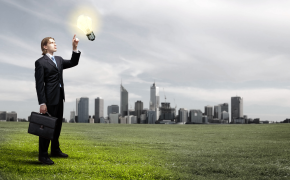Updated
Next update
Not yet determined
See all figures from this statistics
About the statistics
The statistics show the number of applications for patents, trademarks and designs sent by enterprises to the Norwegian Industrial Property Office over a year. In addition, it shows enterprises applications by industry and size group, measured by the number of employees.
Definitions
-
Patent: A patent protects a concrete solution to a technical problem.
Patents are granted for inventions. The invention must represent a practical solution to a problem where the solution has a technical nature, technical effect and is reproducible. An idea or business concept cannot be patented without explaining or showing how it can be implemented in practice. Processes, products, systems and applications can be patented, such as blood analysis, computer technology and zips.
Trademark: A trademark is a distinctive characteristic of a product and/or service. A trademark can consist of all kinds of characteristics, and must be capable of being represented graphically. A trademark may for example consist of words and combinations of words (e.g. slogans), names, logos, characters and images, letters, numbers, packaging, sound and motion, or combinations thereof.
Design: Design refers to the appearance and shape of a product or a part of a product.
The following can be protected by design:
- The shape and appearance of a product, such as the design of a toothbrush, car, ship, phone or a piece of furniture.
- Parts of the product, such as a toothbrush head, chair legs, phone keyboard.
- Appearance on non-physical objects such as layouts for the web, mobile design, typographic fonts and graphic symbols. Computer programs are not eligible for design protection.
- An ornament, such as the decor of crockery or figures on textiles and wallpaper.
- An interior arrangement, such as a café or shop interior.
Enterprise: The smallest combination of legal entities that together form an organizational unit that produces goods or services, which benefits from a certain degree of independent decision-making powers, particularly with regard to its current resources. In most cases, the entity would be the same as the legal entity, such as a corporation.
-
Patents are primarily classified by the International Patent Classification system (IPC). SSB patent data are available on the aggregate engineering fields based on IPC.
Enterprise applicants are classified by:
- Standard Industrial Classification (SN2007), based on NACE Rev. 2
- Size class by number of employees
Administrative information
-
Name: Patents, design and trademarks
Topic: Technology and innovation
-
Division for Business Dynamics Statistics
-
National and county.
-
Annually.
-
Not applicable.
-
Raw data and linked data are stored in line with Statistics Norway’s standard routines for archiving of files.
Background
-
Intellectual property rights are often used as an indicator for innovative activity; a performance indicator for innovation. This applies particularly to patents. A high degree of patenting is considered to indicate a high level of innovativeness.
A patent gives the patent holder the exclusive right to exploit inventions, which can be new products, processes or applications, such as solutions to a technical problem (the business perspective). In return, the invention must be made public. The information will partly prevent the use of resources on known inventions, partly represent inspiration for further development and, not least, patents may be used freely by others after the expiry of the rights (the social perspective). Patents can entail high development costs, and the willingness to invest in development is assumed to be greater when an exclusive right can be achieved, thereby stimulating innovation.
A registered trademark protects investments that are made to differentiate a product or service from others on the market.
An approved design protects the appearance and shape of a product or part of a product.
-
Users are government ministries and agencies, The Research Council of Norway, research institutions, industry and professional organisations.
-
Not relevant
-
Enterprise and firm level data can be linked to other statistics, but there is no direct connection.
-
The raw data are collected on the basis of a cooperation agreement with the Norwegian Industrial Property Office under on the Statistical Act of 1989.
-
Not applicable.
Production
-
All applications for intellectual property rights (patents, trademarks and design) that are submitted to the Norwegian Industrial Property Office. Patent applications sent directly to the European Patent Office are not included.
-
Register data from the Norwegian Industrial Property Office. The unit is each single application.
-
Information on each application is received from the Norwegian Patent Office. In cases where the applicant is determined to be an enterprise, information from the Norwegian Central Register of Establishments and Enterprises (VoF) is added (organisation number, industrial activity and number of employees).
-
Not relevant
-
In general, information on intellectual property rights and applications are made publicly available; patent applications are only accessible after 18 months.
Data with additional information from Statistics Norway are treated as confidential and are subject to confidentiality and will be stored and destroyed accordingly. All use must comply with the applicable requirements of The Norwegian Data Protection Authority.
Publication will take place in accordance with the Statistics Act and Statistics Norway’s internal rules of confidentiality. The general rule is that data are not released if they can be traced back to the applicant in any way.
-
Not applicable.
Accuracy and reliability
-
Additional information on the applicants’ industry classification and employment are taken from the Norwegian Central Register of Establishments and Enterprises (VoF) based on the identification of the applicants’ organization numbers. In some cases there may be uncertainty about the correct attribution of an application to an enterprise and thus also uncertainty with regards to the correct industry classification and size group.
-
Not relevant
Analyses, articles and publications

The effects of innovation policies on firm level patenting
Published 10 December 2015This paper examines the impacts of R&D tax credits and direct R&D subsidies on Norwegian firms' patenting, with a particular focus on environmental patenting.
Read this publicationContact
-
Claudia Berrios
